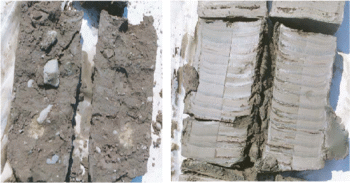TAKING THE MYSTERY OUT OF COMPLEX GLACIAL SEQUENCES AT ENVIRONMENTAL AND GEOTECHNICAL SITES
Part I: Deciphering Stratigraphy and Depositional Environments
Hydrogeologists and geotechnical engineers face a common problem: how do you take the mystery out of the subsurface at sites underlain by complex glacial sequences � sequences featuring deposits from successive glacial advances with interbedded stratified meltwater deposits occurring as isolated lenses within a glacial unit or as continuous stratified units between successive glacial advances?
For hydrogeologists, a key is knowing whether the various stratified meltwater deposits are contaminant pathways through continuous units underlying the site or if they are merely isolated lenses within a fine-grained glacial unit. Related questions include:
- Where should well screens be set to monitor a contaminant pathway?
- How can the stratigraphic sequence be identified so that groundwater flow patterns beneath the site can be characterized and understood?
The questions are no less challenging for geotechnical engineers. How can the stratigraphic sequence beneath the site be determined so that the effects of site stratigraphy on foundation conditions can be assessed?
- What is the stratigraphic sequence beneath the site?
- How do I successfully sample the sequence to determine foundation conditions, cut slope stability or soil borrow source characteristics?
What does taking the mystery out of such complex subsurface conditions require? An understanding of glacial stratigraphy, glacial depositional environments, and the magnitude of any post-depositional weathering alteration.

(Discover how unit identification, distribution and physical properties are controlled by depositional environment. Apply your observations to environmental and geotechnical sites.)
This webinar, Part I, provides techniques for identifying and understanding glacial stratigraphy and depositional environments. These techniques are based on an understanding of glacial depositional environments, glacial sedimentology, and regional glacial stratigraphy. Join us for this webinar and learn how to take the mystery out of the complex glacial sequences underlying your environmental and geotechnical sites.
This webinar is the first part in a Three Part Series in characterizing complex glacial sedimentary successions.
"The training webinars are of high quality. They were easy to use... We projected our webinars to a large screen TV mounted on the wall in our conference room. We had good clarity for sound and picture...
The content was also appropriate. Personally, I liked the overall message that high quality soil boring logs are essential to better understanding of site characterizations. How can we adequately assess the nature & extent of environmental impact (and the selected remedial actions) without adequate site characterizations."
- Mark Nichter, US Army Corp of Engineers
Instructor Bio
Tim Kemmis, PhD, PG
 Tim Kemmis received his bachelor's degree in agricultural soil science from the University of Illinois and his master's degree in glacial geology while working as a graduate assistant at the Illinois State Geological Survey.
Tim Kemmis received his bachelor's degree in agricultural soil science from the University of Illinois and his master's degree in glacial geology while working as a graduate assistant at the Illinois State Geological Survey.
He worked 14 years for the Iowa Geological Survey, during which he received his Ph.D., and where he:
- Carried out glacial sedimentologic investigations
- Remapped the Des Moines Glacial lobe
- Established the formal glacial stratigraphy for the lobe based on depositional environments
- Discovered a new type of hummocky glacial topography
- Determined the geometry and origin of jointing in glacial tills
- Developed a lithofacies code to decipher the history of glacial outwash and alluvial sequences
For most of the time since 1992, Tim has worked as a senior geologist consultant and project manager for large-scale hydrogeologic investigations. His unique experience as both an applied researcher and consultant has allows Tim to effectively unravel sedimentary complexities coupled with his personal ability to teach these concepts to all staff levels.
| Fee: |
299.00 USD Per Webinar
|
| Materials and Downloads: |
Session Slides (PDF)
Additional MaterialsRecord of Attendance Form (PDF)
|
Number of
Participants: |
AS OF JUNE 1, 2020, WEBINARS ARE PRICED FOR INDIVIDUALS WORKING ALONE. Pricing is discounted for individual registrations for people working alone.
|
Continuing
Education
Certificates: |
$14.95 each. Official CEU certificates are available as an option. After successful completion of this webinar, a link will be provided to order a certificate.
|
| Access: |
On-demand, anytime 24/7. |
| Discounts: |
Buy 3 on-demand webinars, and get 3 on-demand webinars for free!
|
| Duration: |
90 minutes |
| PDH Earned: |
1.5 hours |
| MA LSP: |
1.5 hours (MA LSP No. 1417-M) |
| CT LEP: |
1.5 hours (part of CT LEP-308E) |
| |
|
| Instructor(s): |
Tim Kemmis, PhD, PG, AECOM Environment, Sheboygan, Wisconsin |